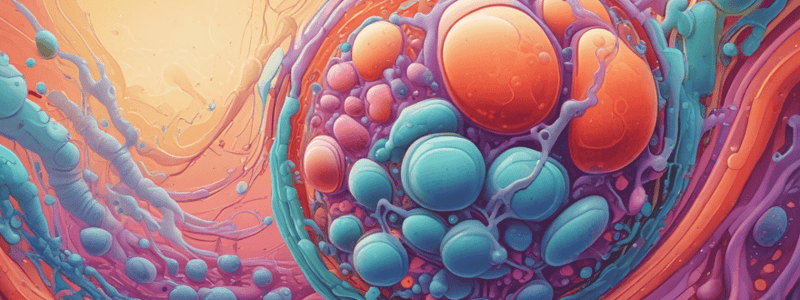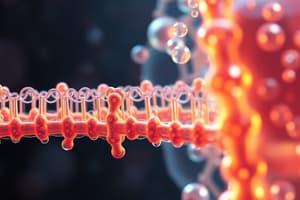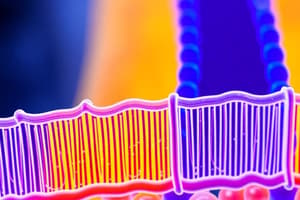Podcast
Questions and Answers
What is the approximate extra-cellular concentration of potassium ions?
What is the approximate extra-cellular concentration of potassium ions?
- 150mM
- 5mM (correct)
- 15mM
- 100mM
What is the direction of ion movement due to concentration?
What is the direction of ion movement due to concentration?
- From high to low concentration (correct)
- Randomly
- No movement
- From low to high concentration
What is the resting membrane potential?
What is the resting membrane potential?
- Not specified
- 0mV
- -60 to -50mV (correct)
- -50 to -40mV
What happens during the upstroke phase of an action potential?
What happens during the upstroke phase of an action potential?
What happens during the repolarisation phase of an action potential?
What happens during the repolarisation phase of an action potential?
What is the function of the refractory period?
What is the function of the refractory period?
During what phase of an action potential do voltage-gated Na+ channels become inactive?
During what phase of an action potential do voltage-gated Na+ channels become inactive?
What is the major intracellular anion?
What is the major intracellular anion?
What is an action potential?
What is an action potential?
How many phases does an action potential have?
How many phases does an action potential have?
Flashcards are hidden until you start studying
Study Notes
Cell Homeostasis
- The lipid bilayer of the cell membrane has a basic fluid structure and is relatively impermeable.
- The lipid bilayer is composed of phosphoglycerides, sphingolipids, and cholesterol, with a hydrophobic tail and hydrophilic head.
- The structure of the membrane is thermodynamically stable.
Cell Membrane Composition
- The cell membrane is composed of proteins, carbohydrates, and phospholipids.
- There are integral or peripheral membrane proteins.
- Cholesterol is present in the membrane, making it more fluid.
Fluidity of the Membrane
- The fluidity of the membrane is important for cell function.
- The fluid mosaic model describes the structure of the membrane.
- There is membrane asymmetry.
Membrane Functions
- The membrane has three main functions:
- Compartmentalization
- Scaffold for biochemical activities
- Platform to exchange contents with the environment
Transport across the Membrane
- There are two main types of transport: passive and active.
- Passive transport occurs with the concentration gradient and includes simple diffusion, facilitated diffusion, and osmosis.
- Active transport occurs against the concentration gradient and requires energy (ATP).
- Examples of disease-relevant transporters include GLUT1, FATP2, and CFTR.
Passive Transport
- Simple diffusion is the movement of small molecules from an area of high concentration to an area of low concentration.
- Facilitated diffusion is the movement of molecules down their concentration gradient with the assistance of transport proteins.
- Osmosis is the movement of water molecules from an area of high concentration to an area of low concentration.
Active Transport
- Active transport requires energy (ATP) and is used to move molecules against their concentration gradient.
- Examples of active transport include the transport of Ca2+ ions and small molecules.
Disease-Relevant Transporters
- GLUT1 is a transporter involved in Glut1 deficiency syndrome.
- FATP2 is a transporter involved in Milder variant of x-linked Adrenolucodystrophy.
- CFTR is a transporter involved in Cystic fibrosis.
Cystic Fibrosis
- Cystic fibrosis is a disease caused by a malfunctioning chloride channel, leading to thickening of mucus.
- The disease affects multiple epithelial tissues, especially in the lungs, liver, kidneys, and intestines.
- The incidence of cystic fibrosis is 1 in 2,500 live births in the UK.
Transport of Large Molecules
- Endocytosis is the process of taking in large molecules through the formation of vesicles.
- Exocytosis is the process of releasing large molecules from the cell through the fusion of vesicles with the plasma membrane.
- There are three types of endocytosis: phagocytosis, pinocytosis, and receptor-mediated endocytosis.
Membrane Potential
- All cells have a membrane potential, which is the difference in electrical potential across the membrane.
- The membrane potential is influenced by the movement of ions (K+, Na+, Cl-, Ca2+) across the membrane.
Polarisation
- When the membrane potential becomes more positive than the resting potential, the membrane is said to be depolarised.
- When the membrane potential becomes more negative than the resting potential, the membrane is said to be hyperpolarised.
Action Potential
- An action potential is a rapid depolarisation of the cell membrane potential that travels along the length of the cell membrane.
- The action potential has four phases: initiation, upstroke, repolarisation, and refractory period.
Phases of Action Potential
- Initiation: the threshold is around -60 to -50mV, and the action potential obeys an all-or-nothing rule.
- Upstroke: voltage-gated Na+ channels open, resulting in an influx of Na+ ions.
- Repolarisation: voltage-gated K+ channels open, resulting in a K+ efflux out of the cell.
- Refractory period: the membrane hyperpolarises and the Na+/K+ pumps restore the resting membrane potential.
Studying That Suits You
Use AI to generate personalized quizzes and flashcards to suit your learning preferences.





